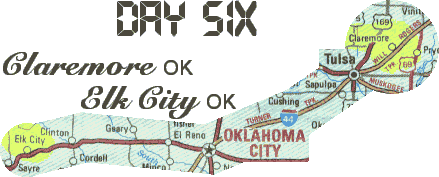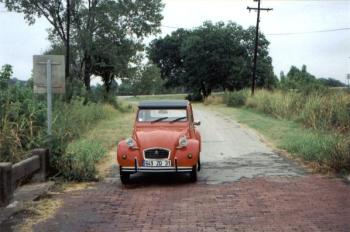
Day Six
After breakfast we stopped at the Will Rogers Museum, a fascinating place.
I knew that Will was a political satirist and a friend to all the politicians of his time, but I had forgotten about his movie and vaudeville careers. In 1919 he was making silent films in California for Sam Goldwyn and eventually made more than 30 films into the 1930’s. It was his “down-home” humor and wit that spawned his political satirist reputation during the Great Depression. He was killed in 1935, along with aviator Wiley Post, in a plane accident in Alaska.
We bypassed Tulsa in order to follow the old road as much as possible.
Before Supulpa, we seemingly lost our way and found ourselves on a one-lane, weed-infested path that skirted farm fields on both sides. We were standing by the car with a map spread on the hood when a gent in bib overalls drove by in his pickup truck and asked if we were lost. We mentioned that we were looking for the old portion of Route 66, but must have missed the turnoff. He said, “Fellas, you’re on it right now. This is as old as it gets. This is part of the 1926 road west”. We tried to picture who rode this “path” west. The road got much more use during and after the dust storms of the 1930’s when entire towns and the people there were swallowed by the unrelenting conditions that literally stripped them of their land and livelihood.
I feel that I must quote John Steinbeck in order for you to get a feel of what it was like to travel on this same road.
“66 is the path of a people in flight, refugees from the dust and shrinking land, from the thunder of tractors and shrinking ownership, from the deserts slow northward invasion, from the twisting winds that howl up out of Texas, from the floods that bring no richness to the land and steal what richness there is. From all of these the people are in flight, and they come into 66 from the tributary side roads, from the wagon tracks and the rutted country roads. 66 is the mother road, the road of flight.”
Arriving in Supulpa, we had cinnamon buns and coffee at Rivett’s Cafe on E. Dewey.
We were looking for Norma’s, a place mentioned in the Route 66 Guide, but couldn’t find it. Not a problem since Rivett’s was filled with local people who considered the Cafe as home. We felt a little out of place because it was hard to relate to really small-town America when we come from truly affluent areas on the west coast.
West of Supulpa we encountered an anomaly, the intersection of “Highway 66” and “Old Highway 66”, perhaps the only acknowledgment of both alignments anywhere on the route. Not previously mentioned: the route west from Chicago underwent many route changes, depending on which farmer would allow access on his land and which township would pay for the roadwork. Therefore, there could be several “original” Route 66 roads heading west.
| At the above-mentioned intersection, we crossed the Rock Creek Bridge, an old steel truss bridge with a well-preserved, red brick paving built in 1921. |

|
Westward Ho! We did, indeed, go through Oklahoma City and, yes, it was mighty pretty.
Heading west, there were two choices:
- the preferred 1932 road
- or a miscalculation in our navigation which took us north on an older route toward Geary and then south to Bridgeport on Route 66.
Rejoining Route 66 west, we passed through Clinton and visited the Route 66 Museum, one of many we saw on our trip.
Just short of the Oklahoma/Texas border, we stopped for the night in Elk City, OK.
After a dinner of catfish and fries, it was a few scotches and a little Olympics and off to dreamland.
|
Previous day |
Next day |